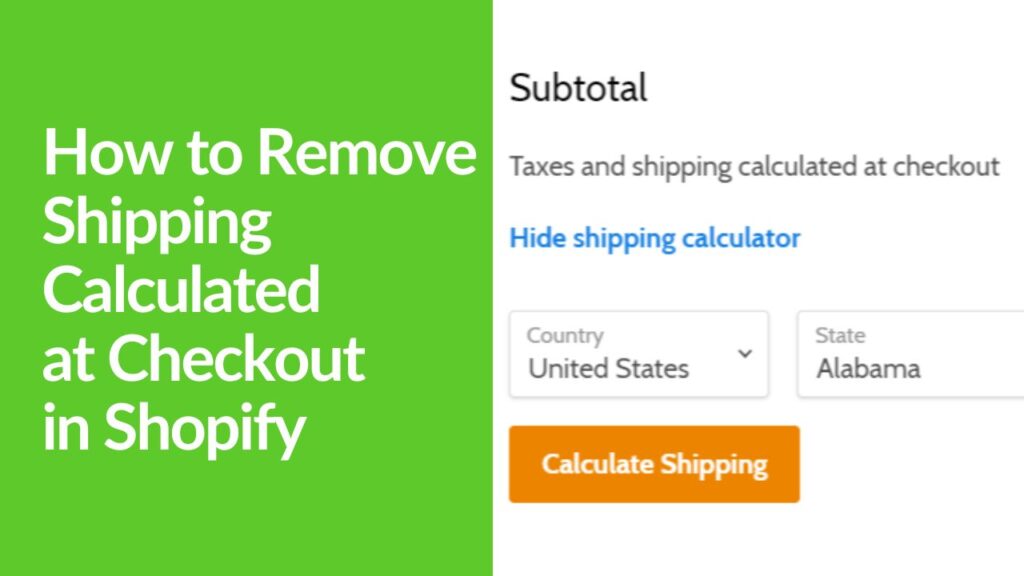Unlock the potential for your Shopify store to thrive with effective checkout optimization. Beyond offering top-notch products and captivating design, success hinges on a streamlined purchasing experience. Dive into 7 proven strategies tailored to ‘Boost Shopify Sales’ by mastering checkout optimization. Elevate conversion rates and enhance the shopping journey for your customers, propelling your online venture towards unprecedented growth.
The Importance of Checkout Optimization in E-commerce
Scooping up every possible sale is the key to success. Cart abandonment is a major obstacle that Shopify business owners must overcome and has a direct effect on sales and growth.
A smooth, hassle-free checkout process can significantly reduce cart abandonment rates and ‘boost Shopify sales’, directly impacting your bottom line.
However, what if you could turn this challenge into a chance? By understanding the critical role checkout plays in customer satisfaction and retention, online business owners can take strategic steps to refine this crucial phase of the shopping journey. ‘Shopify sales’ may be greatly increased and cart abandonment can be dramatically decreased with the help of ‘checkout optimization’.”
Boost Shopify Sales through Checkout Optimization
Streamlining the Checkout Process
Simplicity is key. A streamlined checkout process minimizes distractions and makes it as easy as possible for customers to complete their purchases. Consider reducing the number of steps required to check out and ensure that each step is clear and straightforward. By implementing these strategies, you can ‘boost Shopify sales’ and enhance the overall shopping experience for your customers.
Implementing Guest Checkout
Mandatory account creation can be a major turn-off for many shoppers. Offering a guest checkout option caters to those looking for a quick and hassle-free purchase, significantly reducing abandonment rates.
The Role of Page Speed in Conversion
How Loading Times Affect Sales
Page speed is not just a technical detail; it’s a critical element of customer experience. Slow loading times can frustrate potential buyers, leading them to abandon their carts. Optimizing your site’s speed ensures a smoother journey from browsing to buying.
Tools for Speed Analysis
Leverage tools like Google PageSpeed Insights to analyze and improve your store’s loading times. These insights can guide you in making technical adjustments that enhance site performance.
Payment Method Diversity
Adding Multiple Payment Options
The more payment options you offer, the wider the net you cast to catch potential sales. Incorporating a variety of payment methods caters to different customer preferences, making it easier for them to say “yes” to your products.
The Impact of Payment Flexibility on Sales
Payment flexibility can significantly boost your conversion rates. By accommodating various payment preferences, you reduce the likelihood of customers abandoning their carts due to a lack of suitable options.
Security: Earning Customer Trust
Displaying Security Badges
Security badges serve as a visual assurance to customers that their personal and payment information is safe. This confidence can be the deciding factor in whether they complete a purchase.
Using SSL Certificates
An SSL certificate encrypts data between your customer’s browser and your Shopify store, safeguarding sensitive information. This not only protects your customers but also boosts your site’s credibility and search engine ranking.
Optimizing Mobile Experience
Responsive Design for Mobile Users
With an increasing number of shoppers using mobile devices, a responsive design ensures your store is accessible and navigable on any screen size. This adaptability enhances the mobile shopping experience, reducing cart abandonment rates.
Mobile Payment Solutions
Incorporating mobile-friendly payment options like Apple Pay and Google Wallet can streamline the checkout process for mobile users, encouraging more on-the-go purchases.
Personalization and Upselling
Product Recommendations
Personalized product recommendations can guide customers toward additional purchases they might not have considered, increasing the average order value.
Cart Upsell Strategies
Introducing upsell opportunities in the cart can tempt customers with complementary products or upgrades, boosting your sales without increasing the buyer’s effort.
Reducing Friction Points
Simplifying Form Fields
Every additional field in your checkout form is an opportunity for a customer to reconsider their purchase. Keep forms as simple as possible, requesting only essential information.
Error Notification Improvements
Clear and immediate feedback on form errors helps customers correct their mistakes without frustration, smoothing the path to purchase.
Engaging Customers Post-Purchase
Thank You Pages
A customized thank you page can leave a lasting impression, encouraging customers to return. Consider including discount codes or related product suggestions to foster repeat business.
Follow-Up Emails
Follow-up emails can serve multiple purposes: expressing gratitude, providing order details, or enticing customers with future offers. These communications keep your brand top-of-mind and nurture customer relationships.
Leveraging Analytics for Improvement
Utilizing Shopify Analytics
Shopify’s built-in analytics tools offer valuable insights into your store’s performance, including cart abandonment rates. Use this data to identify trends and areas for optimization.
A/B Testing for Checkout Optimization
Experiment with different checkout layouts, forms, and processes through A/B testing. This methodical approach allows you to pinpoint what works best for your store and customers.
Customer Feedback and Iteration
Gathering Customer Insights
Feedback from your customers is invaluable in refining your checkout process. Regularly seek out and act on their input to continuously enhance the shopping experience.
Implementing Feedback for Continuous Improvement
The cycle of gathering feedback, implementing changes, and measuring results is key to ongoing optimization. Stay responsive to customer needs and market trends to keep your checkout process in top form.
Understanding Cart Abandonment
At the heart of improving your Shopify sales lies in understanding why shoppers leave without completing their purchases. Picture this: You’ve spent hours curating the perfect collection of products on your Shopify store. Your website traffic is booming, and customers are adding items to their carts like there’s no tomorrow.
But then, just as you’re about to pop the champagne in celebration, reality hits you like a ton of bricks—cart abandonment strikes, and those potential sales vanish into thin air.
High cart abandonment rates often signal friction points within the checkout process that deter potential buyers. Identifying and addressing these issues is the first step toward crafting a seamless shopping experience. By doing so, you can ‘boost Shopify sales’ and turn potential losses into substantial gains.
Cart Abandonment: Why it Happens
You can significantly increase sales by reducing cart abandonment on your Shopify store. It’s frustrating when potential customers load up their carts and then suddenly bail. First things first, let’s get into the minds of these buyers. Why do they abandon their carts? Well, there are a few psychological factors at play:
- Unexpected Costs: Picture this: a customer is happily adding items to their cart, feeling all good about their choices, and then bam! Shipping fees or taxes pop up at checkout. It’s like a rude awakening. They might feel tricked or like they’re not getting the deal they thought they were. So, they bolt.
- Indecision: Sometimes, people just can’t make up their minds. They might have second thoughts about the product, whether it’s the right fit for them or if they really need it. They might leave to ponder on it and end up forgetting altogether.
- Trust Issues: Trust is key in online shopping. If your site looks sketchy or if there are security concerns, buyers are out. They need to feel confident that their personal and payment information is safe with you.
- Complicated Checkout Process: Ever been to a store where the cashier seems to take forever to process your payment? Yeah, it’s annoying. The same goes for online shopping. If the checkout process is too long or complicated, people will bounce.
How to Reduce Cart Abandonment?
At the heart of improving your Shopify sales lies in understanding why shoppers leave without completing their purchases. Friction points in the checkout process can discourage potential customers. Identifying and addressing these issues is the first step toward crafting a seamless shopping experience
Now that we’ve identified the root cause of cart abandonment, the first step in creating a smooth shopping experience is recognizing and resolving these problems. how do we address these issues and reduce cart abandonment?
- Transparent Pricing: Be upfront about all costs from the get-go. Display shipping fees and taxes early on so there are no surprises at checkout.
- Clear Return Policy: Let customers know they can return items hassle-free if they’re not satisfied. It builds trust and removes a barrier to purchase.
- Security Assurance: Display trust badges, SSL certificates, and any other security measures prominently on your site. Make it clear that their information is safe with you.
- Streamlined Checkout: Keep it simple, folks. Minimize the number of steps required to complete a purchase. Nobody likes jumping through hoops.
- Abandoned Cart Emails: Don’t let those abandoned carts go to waste! Send friendly reminder emails with incentives like discounts or free shipping to nudge customers back to complete their purchases.
Remember, it’s all about making the buying process as smooth and painless as possible for your customers. Address their concerns, build trust, and watch those abandoned carts dwindle away.
Case Studies: Success Stories
Exploring real-life examples of Shopify stores that have successfully optimized their checkout processes can provide inspiration and practical insights. Learn from their strategies and outcomes to apply similar tactics to your own store.
The Journey of LuxePets
LuxePets, an emerging pet accessories brand, realized their Shopify sales plateaued despite a steady flow of website traffic. Digging deeper, they identified a significant drop-off rate during the checkout process. With a proactive approach, they revamped their checkout flow, simplifying steps and reducing form fields.
By integrating express checkout options and emphasizing security measures, LuxePets enhanced user trust and streamlined the purchasing journey. Within weeks of implementation, their Shopify sales surged by 30%, marking a notable milestone in their growth trajectory.
The Evolution of TechGear
TechGear, a reputable electronics retailer, recognized the need to optimize their Shopify checkout experience to stay ahead in the competitive market. Analyzing customer feedback and browsing behavior, they identified bottlenecks in their existing checkout process. Implementing a responsive design, they ensured seamless navigation across devices. Additionally, TechGear introduced guest checkout features and personalized recommendations, significantly reducing cart abandonment rates. Through meticulous A/B testing and continuous iteration, TechGear witnessed a remarkable 25% increase in ‘Boost Shopify Sales’ within a quarter, reaffirming their position as an industry leader.
The Triumph of NatureNest
NatureNest, a nature-inspired lifestyle brand, faced challenges in converting website visitors into paying customers on their Shopify platform. Recognizing the critical role of checkout optimization, they prioritized enhancing user experience and reducing friction points. By implementing a one-click checkout option and offering multiple payment gateways, NatureNest catered to diverse customer preferences.
Leveraging persuasive copy and visually appealing design elements, they instilled confidence and urgency during the checkout process. The results were astounding, with NatureNest witnessing a staggering 40% increase in Shopify sales within a month, surpassing their growth projections and setting a new standard for success.
Frequently Asked Questions (FAQs)
How can I track cart abandonment on my Shopify store?
To track cart abandonment on your Shopify store, you can utilize analytics tools such as Google Analytics or Shopify’s built-in analytics dashboard.
What role does email marketing play in reducing cart abandonment?
Sending targeted email reminders, personalized offers, and incentives can encourage customers to return to complete their purchases.
Is it beneficial to offer discounts to reduce cart abandonment?
It’s essential to strike a balance to avoid devaluing your products or eroding profit margins. Consider offering discounts strategically, such as for first-time customers or as part of a limited-time promotion.
How can social proof be leveraged to reduce cart abandonment?
Displaying social proof prominently throughout the checkout process can reassure customers and alleviate concerns, reducing cart abandonment rates.
What role do trust badges play in checkout optimization?
Trust badges, such as SSL certificates and security seals, signal to customers that your website is secure and trustworthy.
Are there any best practices for optimizing product pages to reduce cart abandonment?
Optimizing product pages with high-quality images, detailed descriptions, and persuasive copy can enhance the overall shopping experience and reduce cart abandonment.




